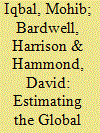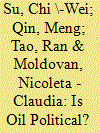|
|
|
Sort Order |
|
|
|
Items / Page
|
|
|
|
|
|
|
| Srl | Item |
| 1 |
ID:
178625


|
|
|
|
|
| Summary/Abstract |
This paper presents significant methodological improvements on Estimating the Global Costs of Violence. It also presents updated estimates of the global economic impact of violence at $14.8 trillion in 2017. This is equivalent to 12.4 per cent of global GDP or $1,988 per person. In the analysis, 163 countries are examined accounting for 99.5 per cent of the global population. The estimate is comprised of three domains which aggregate to yield a global estimate of the economic impact of violence. These three domains are the costs of interpersonal violence, the costs of collective violence and the expenditures on violence containment. A model of the economic cost of violence is established using a bottom-up accounting approach. This model follows the methodology of the 2018 Global Peace Index (GPI).
|
|
|
|
|
|
|
|
|
|
|
|
|
|
|
|
| 2 |
ID:
178631


|
|
|
|
|
| Summary/Abstract |
Conscription typically involves migration to the duty base location. According to DaVanzo’s theory of repeat migration, this military-motivated migration might foster post-military migration. This paper investigates this issue empirically using individual-level data drawn from the 1992, 1998, and 2001 editions of the French survey of labor market entrants ‘Génération.’ The methods used to identify the causal effect of compulsory peacetime conscription on the post-military propensity to migrate exploit the abolition of conscription in France in October 1997 plus information on the timing of service among those who served. Conscription stimulated the post-military propensity to migrate for work of French male labor-market entrants with upper-class origins. Furthermore, there is evidence of a previously overlooked anticipatory effect of conscription: French males who were waiting to be called up for military service were approximately 25% less likely to migrate for work than comparable non-conscripts. Some implications of these findings and a consideration of their external validity are also provided.
|
|
|
|
|
|
|
|
|
|
|
|
|
|
|
|
| 3 |
ID:
178623


|
|
|
|
|
| Summary/Abstract |
Despite calls to reduce illicit arms flows, it remains difficult to detect and quantify them. One proposed method for detecting and quantifying illicit trade volumes is to test econometrically for price changes. This paper documents an effort of the Peace Research Institute Oslo (PRIO) and the Small Arms Data Observatory (SADO) to make such inferential econometric analyses possible by assembling two new datasets on illicit small arms prices. The first, called the ‘Illicit Small Arms Prices – Transactions’ dataset (iSAP-T), has an observational unit of arm(s) sold in a single transaction. The second, called the ‘Illicit Small Arms Prices – Countries’ dataset (or iSAP-C), derives from the iSAP-T and has the more standard country-year observational unit. This paper describes the methods for data collection, organization, and generation for these datasets, presents some descriptive statistics and graphics, and concludes with a discussion of possible future uses and limitations of the datasets.
|
|
|
|
|
|
|
|
|
|
|
|
|
|
|
|
| 4 |
ID:
178628


|
|
|
|
|
| Summary/Abstract |
This paper investigates the political property of oil from the perspective of geopolitical risk (GPR). We explore the relationship between GPR and oil price (OP) by performing the full-sample and subsample rolling-window bootstrap Granger causality tests. We find that wars will lead to an increase in OP but that low GPR cannot lead to an immediate decline in price. This finding can also be explained by economic crises, which can make OP soar while GPR is low. In turn, the rise in OP has a positive impact on GPR. The oil market has a significant interaction with geopolitical events, which reflects the pattern of global politics, so we can conclude that oil has a political property. In the context of a tense and complex global relationship, the world can benefit from the political property of oil to prevent GPR, which can in turn facilitate an accurate prediction of OP to reduce the adverse effects of large fluctuations in the oil market.
|
|
|
|
|
|
|
|
|
|
|
|
|
|
|
|
| 5 |
ID:
178629


|
|
|
|
|
| Summary/Abstract |
In this paper, we attempt to delineate the relevance of geopolitical risk in the oil-stock nexus in a time-frequency domain. We resort to various wavelet coherence methods to capture the influence of geopolitical risk on the dynamic association between oil and stock prices in Saudi Arabia as a rich oil-exporting country in a region with high geopolitical risk. We primarily show that the role of geopolitical risk in the oil-stock interplay varies through timescales and investment horizons. News regarding geopolitical tensions affects the stock market in high frequency bands, while oil impacts are manifested more on longer time-horizons. Geopolitical risk weakens oil-stock connectedness in the short term. Interestingly, geopolitical incidents significantly lower the oil-stock magnitude and volatility correlation. These results offer prominent insights for investors and policy makers, which may be beneficial when responding to future geopolitical tensions in terms of risk management and the identification of investment opportunities.
|
|
|
|
|
|
|
|
|
|
|
|
|
|
|
|
| 6 |
ID:
178626


|
|
|
|
|
| Summary/Abstract |
The paper provides evidence that large-scale land acquisitions in Sub-Saharan Africa raise the likelihood of experiencing outbursts of organized violence. This evidence is achieved through a spatially disaggregated approach, to account for local characteristics, and a quasi-experimental research design, implemented to overcome limitations due to missing geo-referenced information about land deals. Domestic acquisitions are particularly significant in explaining organized violence outbreak, suggesting that the national concentration of power among economic elites hinder social stability. Further, the institutional framework, which forms the background for LSLAs, is a prominent determinant of organized violence occurrence. In particular, more egalitarian and inclusive societies are less prone to conflicts, even in the presence of LSLAs. When land deals are finalized to the cultivation of agricultural commodities for biofuels, the effect is less evident and violence partially depends on climate conditions. On the other hand, land deals still in implementation stage seem to narrow organized violence, possibly due to both local control of areas under investments and socio-economic effects of the deals. Results also show the existence of significant spatio-temporal dependence path, since events of organized violence tend to be recurrent and to persist in space, feeding ‘neighbouring’ effects of proximity and local patterns of violence concentration.
|
|
|
|
|
|
|
|
|
|
|
|
|
|
|
|
|
|
|
|
|